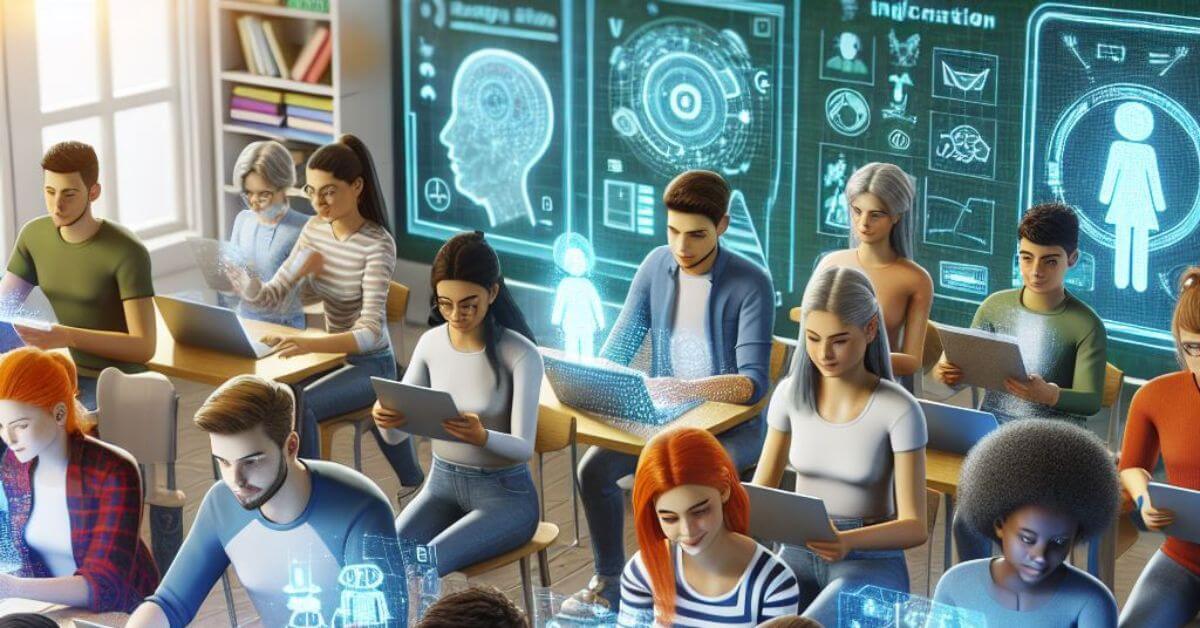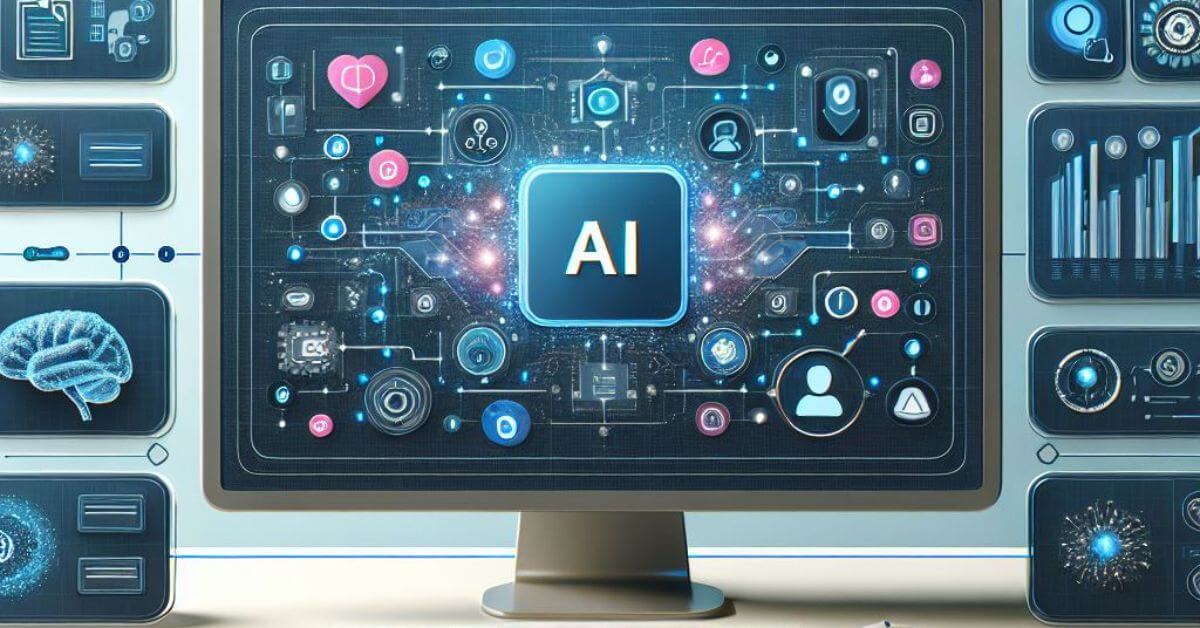Disclosure: This article was created with the assistance of AI technology and is not sponsored.
Introduction: Embracing the AI Revolution in Education
Picture this: a classroom where every student is excited, fully engaged in their learning, and progressing at a pace that’s just right for them. Sounds pretty amazing. Well, thanks to the incredible advancements in artificial intelligence (AI), this vision of the future of education is becoming a reality.
AI is making waves across various industries, and education is no exception. From personalised learning platforms to intelligent tutoring systems, AI is transforming the way we teach and learn, making education more inclusive, effective, and, dare we say, fun!
In this blog post, we’ll explore the exciting ways AI revolutionises the classroom, highlighting real-world applications, exploring the benefits for students and educators and addressing the ethical considerations of embracing this powerful technology. So, buckle up and prepare for a fascinating journey into the future of learning!
Artificial Intelligence in Action: Real-World Applications Transforming Education
Let’s dive into the heart of the matter and see how artificial intelligence already makes a tangible difference in education. Here are a few key areas where AI is shining:
Personalised Learning: Tailoring Education to Every Student

We all learn differently, don’t we? Some are visual learners, others prefer hands-on activities, and some thrive in a structured environment. Traditional classrooms often need help to cater to these diverse learning styles, leading to some students falling behind.
This is where AI steps in, like a superhero with a personalised learning plan for every student! AI algorithms can analyse vast amounts of data about each student, including their strengths, weaknesses, preferences, and learning pace. This allows AI-powered learning platforms to create customised learning pathways, delivering content and activities ideally suited to each individual.
Think of platforms like Coursera and Khan Academy, which use AI to recommend courses and learning materials based on your interests and progress. DreamBox Learning, a platform for K-8 maths, takes it further by adjusting the difficulty level and pace of lessons based on how each student is doing.
Republic of Korea’s Ministry of Education: Develops AI-powered digital textbooks tailored for diverse student proficiency levels, aiming to enhance personalized learning and reduce the reliance on private education.
UAE Ministry of Education: Co-develops an AI-powered virtual tutor to enhance personalized learning, aiming to improve academic performance and promote educational equity across diverse student populations.
This personalised approach leads to increased engagement, better retention of information, and, ultimately, improved learning outcomes. McKinsey & Company even found that personalised learning can boost student performance by up to 30%!
Adaptive Assessments: Evaluating Knowledge with Precision
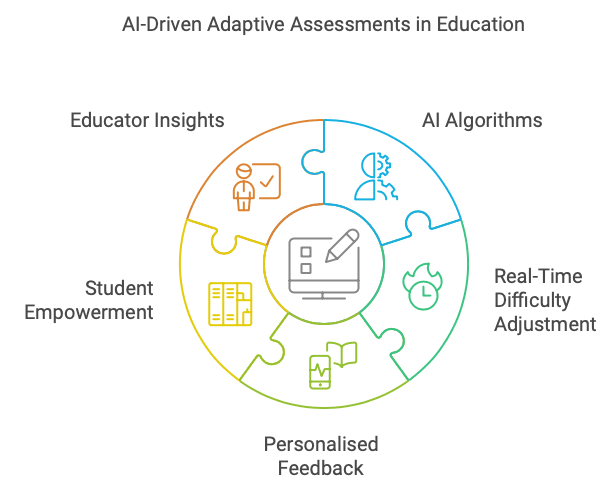
Remember those standardised tests that filled you with dread? Well, AI is helping to make assessments more intelligent and less intimidating. Adaptive assessments, powered by AI algorithms, can adjust the difficulty level of questions in real time based on student performance. I still remember taking the adaptive GMAT exam in the early 2000s, a time when AI was not yet integrated into standardized testing
If you’re breezing through the more straightforward questions, the assessment will challenge you with more complex ones. And if you need help, it will provide support and guidance to help you grasp the concepts.
Platforms like ALEKS are leading the way in adaptive assessments. ALEKS can identify knowledge gaps by constantly analysing student responses and providing personalised feedback to help students target their learning efforts. This gives educators a more accurate picture of student understanding and empowers students to take ownership of their learning journey.
Virtual Classrooms and AI Tutors: Learning Beyond the Traditional Walls

Imagine being able to attend a class from anywhere in the world or having a tutor available 24/7 to answer your questions whenever they pop up. With AI, these possibilities are no longer a distant dream.
AI-powered virtual learning environments are breaking geographical barriers and making education more accessible. VIPKid, an online education platform, uses artificial intelligence to connect English teachers with students worldwide, providing real-time feedback and personalised learning experiences.
But what about those times when you need extra help outside of class? That’s where AI tutors come in. Platforms like Squirrel AI and Carnegie Learning use AI algorithms to simulate the role of a human tutor, providing on-demand support, explanations, and practice exercises.
Kabakoo Academies (West Africa): Utilizes AI-enabled virtual mentors to provide personalized learning experiences and mentorship, preparing young people for self-employment in informal economies.
These AI tutors can adapt to each student’s learning style and pace, offering a level of personalised attention that’s difficult to achieve in a traditional classroom setting.
Administrative Automation: Freeing Up Educators’ Time

Teachers have much on their plates, from lesson planning and grading to managing administrative tasks. AI is stepping in to lend a helping hand, automating routine tasks and freeing up educators’ time so they can focus on what they do best: teaching and mentoring students.
Imagine a world where grading is done in a flash and scheduling parent-teacher meetings is a breeze. Platforms like GradeScope use AI to automate grading, providing quick and accurate feedback on assignments and exams.
IBM’s Watson Education Assistant can handle various administrative tasks, such as scheduling, communication, and even providing personalised learning recommendations for students.
This allows teachers to dedicate more time to interacting with students, providing individualised support, and fostering a more engaging learning environment.
Empowering Functional Needs Education: AI as a Supportive Tool

Let’s remember the students who face unique learning challenges. Artificial intelligence has the potential to be a game-changer in functional needs education, providing personalised support and making learning more accessible for everyone.
Imagine a world where a student with a speech impairment can communicate more easily using speech recognition software, or a student with dyslexia can benefit from predictive text tools. AI can help make these scenarios a reality.
AI-powered tools can analyse data about students with support needs to create individualised learning plans and suggest strategies to help them overcome their challenges.
For example, platforms like SchoolAI can help students improve their conversational and debating skills by providing opportunities to chat with AI assistants about different subjects. Voiceitt, a remarkable tool, can convert unusual speech patterns into understandable language, empowering individuals with speech difficulties to express themselves more effectively.
UNICEF’s Accessible Digital Textbooks initiative: Employs AI to develop digital tools that support diverse learning needs, particularly benefiting students with disabilities by providing customizable, inclusive, educational resources.
Microsoft’s Immersive Reader: A tool that assists students with learning disabilities by providing text-to-speech, translation, and other support features. Google’s Read&Write: A tool that enhances accessibility for students with learning disabilities.
AI can also assist in creating more inclusive classrooms by providing real-time translation and captioning services. This ensures that all students can fully participate in the learning process regardless of their abilities.
AI in Language Learning: Breaking Down Barriers

Learning a new language can be an exciting but challenging endeavour. But fear not, language enthusiasts, AI is here to make the journey smoother and more enjoyable!
AI-powered language learning platforms like Duolingo use sophisticated algorithms to provide personalised lessons, vocabulary drills, and interactive exercises. They can even provide real-time feedback on your pronunciation and grammar, helping you to refine your skills more effectively. Thanks to Duolingo, I now can speak survival Chinese, Japanese and Spanish
Imagine practising your Spanish with a virtual conversation partner who can adjust their speech patterns and vocabulary to match your level. Or think about using an AI-powered translator that translates words and explains the nuances of grammar and cultural context. AI is making language learning more engaging, accessible, and effective.
Keeping Exams Honest with AI Proctoring

With the rise of online learning, ensuring the integrity of exams has become increasingly important. Cheating can undermine the value of education and create an unfair playing field for students.
Enter AI proctoring, a technology that uses artificial intelligence to monitor students during online exams. AI proctoring systems can detect suspicious behaviour, such as looking away from the screen for extended periods, using unauthorised materials, or even having someone else take the exam in the student’s place.
Platforms like EXAMONLINE and Proctorio use AI to analyse real-time audio and video data from exams. They can flag potential violations and alert proctors to investigate further, ensuring that exams are conducted fairly and honestly.
Benefits of Artificial Intelligence in Education: A Win-Win for Students and Educators
By now, it’s clear that artificial intelligence is having a transformative impact on education. Let’s take a step back and look at the overall benefits that this technology brings to the table:
For Students:
- Personalised Learning: AI tailors education to individual needs and learning styles, making learning more engaging and effective.
- Increased Accessibility: AI-powered tools make learning more accessible for students with disabilities, breaking down barriers to education.
- 24/7 Support: AI tutors and virtual assistants provide on-demand support, answering questions and offering guidance whenever needed.
- Engaging Learning Experiences: AI enhances learning with interactive simulations, games, and virtual reality experiences.
- Improved Learning Outcomes: Personalised learning and timely feedback contribute to better academic performance and a deeper understanding of concepts.
For Educators:
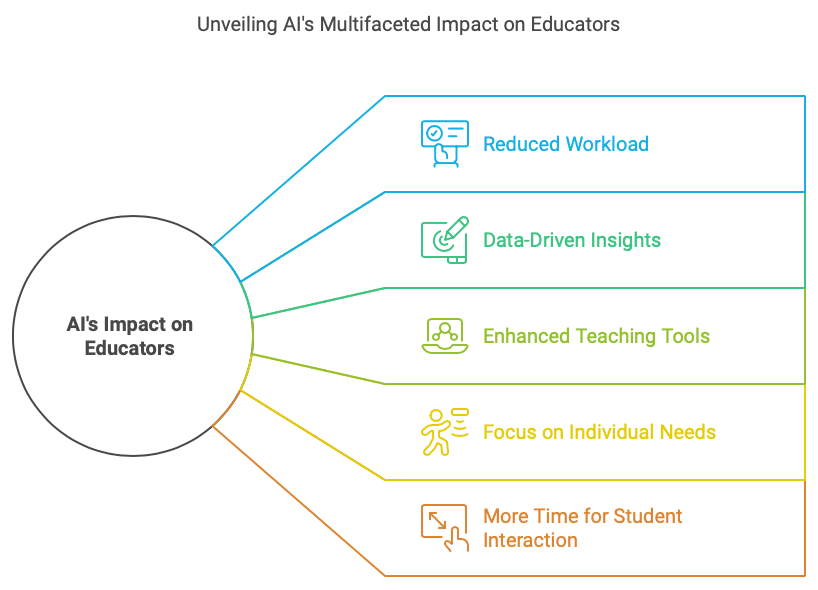
- Reduced Workload: AI automates administrative tasks, freeing educators’ time for teaching and mentoring students.
- Data-Driven Insights: AI provides valuable insights into student performance, helping educators identify areas for improvement and tailor their teaching strategies.
- Enhanced Teaching Tools: AI-powered platforms offer interactive teaching resources, adaptive assessments, and personalised learning plans.
- Focus on Individual Needs: AI empowers educators to provide individualised student support, addressing specific learning challenges.
- More Time for Student Interaction: By automating routine tasks, AI allows educators to interact more with students, fostering a more engaging learning environment.
Ethical Considerations: Navigating the AI Landscape Responsibly
As with any powerful technology, integrating AI into education involves ethical considerations that we must address thoughtfully.
- Data Privacy and Security: Protecting student data is paramount. AI systems must be designed with robust security measures and comply with data privacy regulations.
- Algorithmic Bias: AI algorithms should be developed and trained on diverse datasets to avoid biases that could disadvantage certain groups of students.
- Transparency and Explainability: It’s essential to understand how AI algorithms make decisions and ensure they are transparent and fair.
- The Role of Human Educators: Artificial intelligence should be seen as a tool to enhance education, not to replace human educators. Maintaining a balance between technology and human interaction in learning is crucial.
The Student Perspective: Voices from the AI-Powered Classroom
So, what do students actually think about AI in their classrooms? Well, they’re pretty excited about it! Many students find that AI tools make learning more engaging and personalised.
One student, Minh N. from Menlo Atherton High School, shared: “I’ve had an incredibly immersive and amazing experience with the Veritas AI program. Some concepts were hard, but the instructors managed to break them down to the point where they were understandable to people with little to no experience with AI.”
Another student, Evelyn C. from Adlai E. Stevenson High School, said: “I went from only knowing that AI meant artificial intelligence to understanding and building my own AI model with a real-world application. Participating in the program has inspired me to continue learning more about AI independently.”
But it’s not all sunshine and rainbows. Some students have concerns about data privacy and the ethical implications of artificial intelligence in education. They worry about how their personal information is used and whether AI might be used to make important decisions about their academic future.
AI for Teacher Training and Professional Development
Now, let’s talk about how AI is helping teachers become even better at what they do. Imagine having a personal coach available 24/7 to help you improve your teaching skills – that’s what AI is making possible!
There are some really cool AI-powered platforms out there that can analyse a teacher’s lessons and provide helpful feedback. For example, the AI Coach platform by Edthena lets teachers record their lessons. Then, it uses AI to give personalised improvement tips.
Here’s how it works:
- Teachers record their lessons and upload them to the platform.
- The AI analyses the video and provides tailored observation tips.
- Teachers reflect on their performance and set goals for improvement.
- The AI suggests resources and strategies to help teachers reach their goals.
The best part? Teachers can do this anytime, anywhere, without waiting for a formal evaluation. It’s like having a supportive mentor in your pocket!
Bridging the Gap: Addressing the Digital Divide and Equity Issues
The tricky part is ensuring everyone can access these fantastic AI-powered learning tools. We must recognise that not everyone has the same access to technology and the internet.
To tackle this issue, there are some significant initiatives out there:
- Providing affordable internet access and devices to underserved communities.
- Offering digital literacy training to help people make the most of these tools.
- AI can be used to create learning content relevant to different cultures and languages.
For example, AI can help translate educational materials into multiple languages, making quality education more accessible for students from diverse backgrounds.
Shaping the Future: Innovations and Trends in AI-Powered Education
Let’s peek into the future of AI in education – it’s pretty mind-blowing!
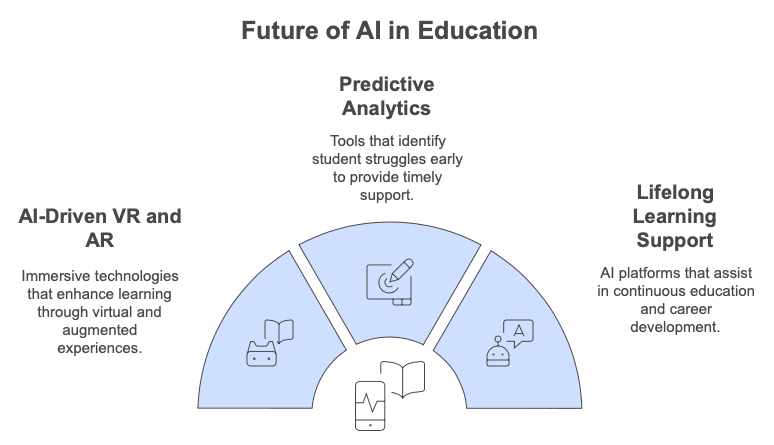
AI-Driven VR and AR Learning Experiences Imagine stepping into ancient Rome or exploring the human body from the inside – that’s what AI-powered Virtual Reality (VR) and Augmented Reality (AR) can do for learning. These technologies can create immersive experiences that make complex concepts easier to understand and remember.
Predictive Analytics for Early Intervention AI is getting really good at spotting when a student might struggle before it becomes a big problem. By analysing homework completion rates, quiz scores, and how students interact with online learning platforms, AI can help teachers provide extra support exactly when and where needed.
AI for Lifelong Learning and Skills Development Learning continues even after you graduate. AI is here to help with that, too! AI-powered platforms can suggest courses based on your interests and career goals, help you identify skills you need to develop, and even match you with job opportunities that fit your unique skill set.
So there you have it – a whirlwind tour of artificial intelligence in education from the student perspective to the cutting-edge innovations shaping the future of learning. It’s an exciting time to be a learner. With the right approach, AI has the potential to make education more accessible, engaging, and effective for everyone. Just remember, while AI is a powerful tool, the human touch – the passion of teachers and the curiosity of students – really brings learning to life!
Conclusion: Embracing the Future of Learning with AI
Integrating AI into education is an exciting journey with immense potential for transforming how we teach and learn. By embracing AI responsibly, we can create more personalised, accessible, and engaging learning experiences for students of all ages.
As AI continues to evolve, we can expect even more innovative applications to emerge, further blurring the lines between the physical and digital classroom. The future of education is here, and it’s powered by AI!
Additional Resources:
- Learn more about AI for Lifelong Learning and how to Stay Ahead in the Age of AI.
- Explore how AI in higher education is shaping the future of universities and colleges.
Reference
- https://www.veritasai.com/student-testimonials
- https://mainstreettowallstreet.com/how-to-start-an-ai-tutoring-business-in-2025/
- https://campustechnology.com/Articles/2024/08/06/Why-Equity-Must-Be-a-Core-Part-of-the-Conversation-About-AI.aspx?admgarea=News
- https://digitalpromise.org/2024/02/20/how-ai-for-education-can-address-digital-equity/
- https://eclox.net/the-future-of-vr-ar-and-ai-trends-and-predictions/
- https://mrccedtech.com/how-ai-revolutionizes-higher-education-with-predictive-analytics/
- https://er.educause.edu/articles/2024/1/will-our-educational-system-keep-pace-with-ai-a-students-perspective-on-ai-and-learning
- https://springsapps.com/knowledge/main-ai-trends-in-education-2024
